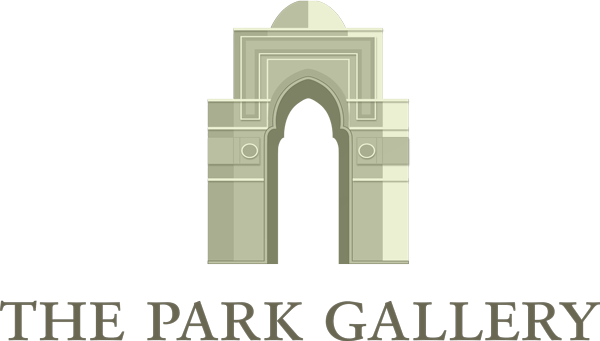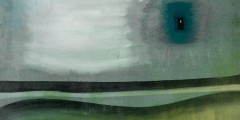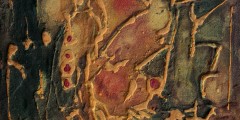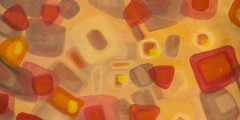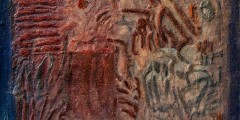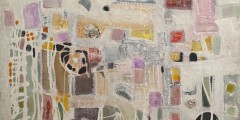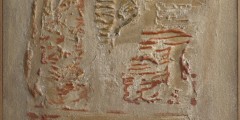Biography
Aref El-Rayess (or Aref Rayess), Lebanese artist, painter and sculptor was born in Aley, a town in the hills above Beirut in 1928. He began to draw and paint at the age of eleven, initially using his mother’s paints and brushes and later learnt to draw with charcoal during vacations on his visits to his cousins’ home in Choweifat, a suburb of Beirut. A self-taught artist, Rayess first exhibited his work publically in 1948, having dedicated his time fully to art since the previous year.
In 1945 Rayess completed a charcoal and pastel drawing entitled Horror, depicting Hiroshima’s atomic bomb, an event that resonated deeply with the artist. The French painter Georges Cyr, architect Antoine Tabet and art critic Victor Hakim came to view the work at the advice of Arlette Levi, a reporter for L’Orient newspaper who had seen the work during a visit she paid to Rayess’ mother. Having been impressed by the young Rayess, Cyr, Tabet and Hakim held an exhibition for him in the West Hall of the American University of Beirut (AUB) in the autumn of 1948.
Sir Julian Sorell Huxley, the first Director-General of UNESCO, and Peter Belew the chairman of UNESCO’s arts section, saw Rayess’ exhibition at the AUB and decided to take six paintings from the exhibition to hang them in the “Imaginary Roaming Exhibition”, held during the Second UNESCO International Conference in Beirut. The remaining thirty-six paintings were exhibited at the UNESCO Palace. The artist moved to Paris in the spring of 1948, where he studied painting in the studios of Fernand Léger and André Lhote, etching with Friedlander and sculpture with Ossip Zadkine amongst others while studying at the Académie de la Grande Chaumière.
Between 1954 and 1956, Rayess travelled in West Africa, spending time exploring the jungles and living with local tribes. During this period he was deeply influenced by the cultural primitivism of the region and African stylization and motifs would become a notable feature of his work at this time, as well as for a large portion of his career. Returning to Paris in 1956, he spent his time attending exhibitions, mixing in artistic circles and concentrating primarily on the skill of etching. He returned to Lebanon between 1957 and 1958 and commenced studies on Phoenician, Assyrian, Sumarite and Pharaonic art. He moved to Florence in 1959 after the Italian Government offered him a one-year scholarship, before he went on to live in Rome from 1960 to 1963, all the while maintaining studios in both cities. It was in Italy that his studies of ancient Semitic art forms manifested themselves in his work through the exploration of symbolism, leading to a large exhibition of works attributed to his ‘Sand Period’, an époque comprising the early 1960s. He presented these works first at Galeria Pogliani in Rome, and then at La Licorne, Beirut, in November 1963, in an exhibition entitled ‘Temps et Murs’.
In 1963, Rayess returned to Beirut and won first prizes in sculpture and tapestry at the national contest of sculpture for the Palace of Justice. In 1969 he was elected chairman of Lebanese Association of Artists and Sculptors, a position he held until 1977. He also taught fine art at the Lebanese University. He counted a number of high profile and respected artists and figures from the art world amongst his friends, including Salwa Raouda Choucair, Michel Basbous and Chafic Abboud. His opinions were also sought and respected by people such as Joseph Abou-Rizk, the director of the Fine Arts department of the National Ministry of Education and he was instrumental in building the Lebanese arts and gallery scene, which was lacking in the 1960s. In 1976 he produced an illustrated book entitled ‘Road to Peace’, that dealt with the theme of the Civil War in Lebanon, something which had affected him greatly.
In the 1980s, Rayess travelled regularly to the Kingdom of Saudi Arabia, spending time living in the country at the beginning of the decade after the outbreak of civil war in Lebanon. He was appointed as the Art Consultant for the city of Jeddah and was commissioned to produce a number of public sculptures for the country, the most ambitious of which is a twenty-seven metre high sculpture of the stylized name of ‘Allah’ that stands in Palestine Square in Jeddah. He travelled to London in 1990 and worked on a number of projects including private commissions around England. In 1999 he held an exhibition of introspective works – produced during the years he spent caring for his ill father, a time of loneliness and anxiety relieved only by the time he found to paint after his father would fall asleep – entitled ‘Labyrinthes 2000’ at the UNESCO Palace.
Rayess spent his latter years working in his native Lebanon and organising the annual Symposia of Painting and Sculpture – the first of which was in 1999 – before he died in 2005. He is fondly remembered and respected not only for his artistic legacy, but also for the influence he had on the development of art in Lebanon in the 20th Century.
